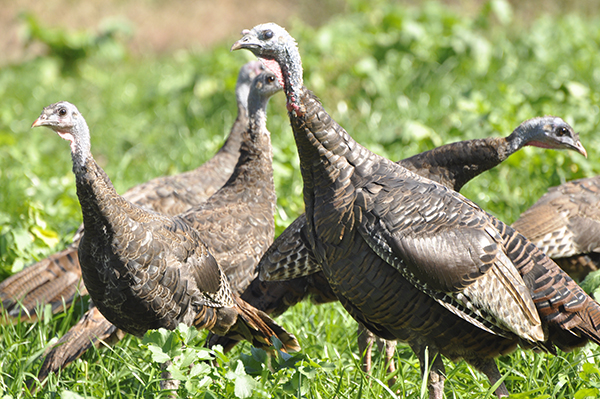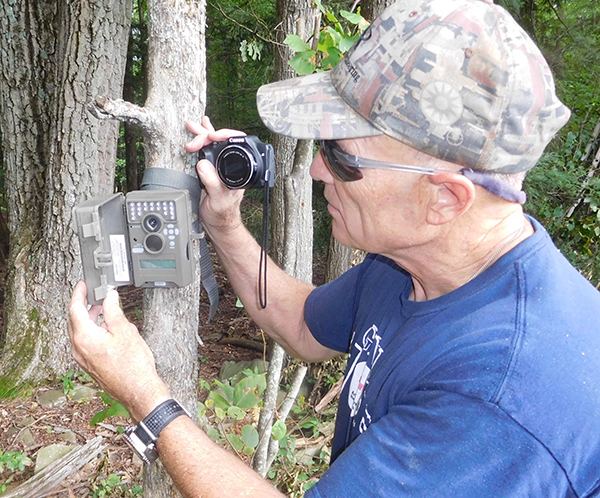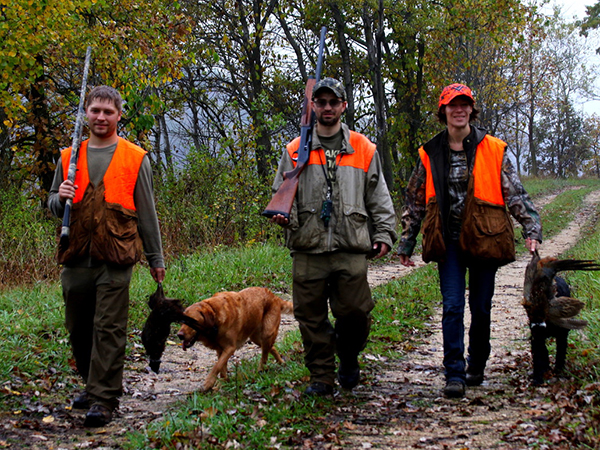The most fun you’ll ever have turkey hunting: busting up a flock in the fall

By Tony Peterson
To be honest, I was on my way to a deer stand when I rounded a corner and realized there were about 14 hens and poults loafing in the alfalfa near me. My deer hunt instantly turned into a turkey hunt as I rushed into the flock, keeping an eye on which way they scattered.
As is almost always the case, it took them longer to fly than I expected, and when they finally took flight, it seemed like almost an even break, which isn’t great. With half the flock on one side of the valley, and half on the other, I scratched out a spot beneath a maple and nocked an arrow.
I knew that it wasn’t ideal because the best busted flocks either scatter in multiple directions, or have one or two that go in the opposite direction of the majority. In this case, I had good-sized mini-flocks that would likely take their time rendezvousing again, and I figured they’d probably get back together in the middle of the cut cornfield in front of me.
Within a few minutes of busting them up, I heard the first helps and kee-kees. I tried to get them fired up with calling of my own, but I could tell it wasn’t meant to be. Even though it was exciting, the birds weren’t calling much, and they were taking their time. Eventually they did meet up, well out of bow range, and I hoofed it down to my stand to restart my original plan.
Busting flocks is like that, but even when it doesn’t produce, it’s still fun. And when it does go well, it’s almost unreal how much action you can have. This is something that just hasn’t caught on much in the Midwest, but I’d be hard-pressed to name a better midday hunt.
The key is to get eyes on a flock and then get close before running in as fast as possible. If you’re gun hunting, do this with your shotgun unloaded because you’ll probably fall down if you’re anything like me. If the birds regroup outside of range, you’ll probably hear them get together and can bust them again, or move on.
When you do bust them, pay attention to where the birds go and set up for the loner or the smaller group and understand that those birds might be back in your lap within a couple of minutes of you rushing through them. And call, call a lot. I use a mouth call in this situation and always try to make it sound like I’m the dominant hen desperate to rally the troops after such a rude interruption.
It’s hard to get folks to ditch other October pastimes to try this technique, but one busted flock done right is all it takes to understand the fun of fall turkey hunting.
Hunter tags black bear in southeast Minnesota
by Rob Drieslein

Winona County, Minn. — A Lewiston man legally tagged a black bear in an unlikely place in late September: southeastern Minnesota. According to a DNR bear researcher, the kill marks only the second time in recent state history that a hunter has legally harvested a bear in the region.
Randy Hoekstra said he’d never had any desire to hunt bears anywhere, much less his 37 acres of bluff country hunting ground south of his home in Lewiston. But when a trail camera began showing a black bear regularly visiting a water tank on his property in western Winona County’s Rupprecht Valley, he figured he’d purchase a tag.
Five years earlier via a trail camera, something large, black and blurry appeared on an image that Hoekstra chalked up to being a wayward beef cow, but friends with bear hunting experience told him he was seeing a bear.
An electromechanic for a malting company in Winona, Hoekstra didn’t think much more of that incident until late this past summer when he saw potential evidence of bear activity in the form of flattened soybeans in an agricultural field. Though he could find no physical evidence of bear activity, the experienced outdoorsman said the several large swaths of flattened crops did not resemble deer damage.
Then, on Sept. 18, the black bear popped up on his trail cam. 

“After it happened several days in a row, I researched bear hunting and bought a no-quota zone tag,” Hoekstra said. “I’d never hunted bears before. Never had, and never really wanted to. I’m a whitetail guy.”
That deer hunting experience came in handy, however, as Hoekstra considered the wind and his stand placement before heading out and successfully bagging the bruin on Friday, Sept. 25 with his muzzleloader.
Winona-area Conservation Officer Tom Hemker said he chatted with Hoekstra, and the bear hunter did everything right in legally harvesting the bear, a rarity in the southeast – the vast majority of black bear harvest in Minnesota occurs in the northeastern part of the state. Hemker said he had heard some bear reports in 2020, including an animal in the vicinity of Great River State Park near Nodine.
Andrew Tri, a DNR bear researcher with the agency’s forest wildlife and populations research group in Grand Rapids, wasn’t available by phone this week but did provide a quick email response to an Outdoor News query about southeast bears.
The agency, he said, knows there is a small population of bears in the so-called “driftless” zone of the state. There have even been documented females with cubs denning up in the region since 1996, he said.
“We don’t have any specific estimates for that part of the state, but the rich mix of oak forest in the driftless with abundant agriculture makes good bear habitat,” Tri said.
To his knowledge, only one bear has ever been harvested in the southeast, back in 2017, near Winona. The southeast is part of the no-quota zone, but only a few hunters ever hunt there each year.
“We presume most of these bears come from Wisconsin, rather than following the river. That said, there’s nothing preventing a few stray bears from up north from heading south,” Tri said.
Outdoor News tried touching base with Don Ramsden, DNR assistant area wildlife manager out of Rochester, for a more local report. He said via email that, for the past 20-plus years, six to eight bears are traveling in the southeast annually.
Hoekstra said he and a buddy estimated the male bear’s weight at 150 pounds, and “he was just full of corn.” They processed the corn-fed bruin into jerky, burger, and roasts, which family and friends have consumed rapidly.
“My son-in-law put bear burgers on the grill, and they tasted like beef. Just excellent,” he said. “We about got him eaten up.”
A taxidermist in Bethany, Minn., has the hide, though a heavy coating of southern Minnesota burdocks in the bruin’s hair could make brushing out a bear rug challenging, Hoekstra said.
Trail cam tricks
by Mike Raykovicz

Of all the gear and gadgets I own, none give me as much satisfaction and pleasure as my trail cameras. By strategically placing them in appropriate locations I’ve gotten pictures of fishers, turkeys, bears, racoons, coyotes, foxes and yes, even deer. However, this success didn’t come without a learning curve.
I bought my first trail camera years ago in the expectation of capturing deer images in the areas I hunt. One location was on a friend’s farm near a large cornfield. It was obvious the deer were eating the corn so, placing the camera on a tree near the edge of the cornfield seemed like a good idea. It wasn’t. The field bordered a line of trees and there was about 20 feet of space between the corn edge and the trees. I fully expected to get photos of deer walking between the trees and the corn. It didn’t happen.
After a week, I decided to go back and swap out the camera’s SD card to check on how many deer showed up. Initially, the card showed more than 300 images and I was elated thinking my hunting location was crawling with deer. Imagine my disappointment when, after opening the images, I found I had about 290 images of moving corn stalks. Since then, whenever I set up a trail camera, I am careful to remove small twigs and grass or, any vegetation that might trigger a response from the camera.
Other mistakes I’ve made include forgetting to turn the camera on and neglecting to put in a fresh SD card when I removed one from the camera. Over the years, I found it’s important to give some thought to what you are doing before simply strapping a camera to a tree.
When placing a camera, I like to put it about waist height and about five to ten yards from where I expect a deer might travel. Each trail camera has a maximum effective range so be sure your cameras set up is within that range. If the camera is too far back it might not trigger, if it’s too close, you might only get a blurry image of the side or back of a deer.
If you are running several cameras as I do, be sure to label your SD cards so that each camera has its own card. Some cards can’t be exchanged between different cameras, so if you mix them, you won’t get the images you expect. To be safe I reformat the card for the next use just in case I mix them up.
After removing a card from the camera, I insert a new one and check the recorded images on my home computer. By viewing an image on my computer, I can either enlarge or lighten it to better see any animal that may appear in the background. It might be a good idea to reformat the card after removing it from the computer just in case cards are accidentally switched between cameras.
Before placing a camera on a tree consider its orientation regarding the sun. A camera facing north or south is best. A camera facing east will be blinded by the morning sun and the same fate will await a camera facing west as the sun sets.
Since most really big bucks move mainly at night, I like to set my camera’s shutter speed to its slowest setting because this generally produces the brightest images.
Finally, use the information provided by your camera to note the date, time, and temperature to help you become aware of the deer’s travel patterns. I have some photos of some really impressive bucks but, these bucks always showed up at night. The only way to kill one of these bucks would be during the rut when they were on the hunt for an estrus doe. Just knowing they lived near my stand was inspiration enough to keep coming back and holding off on shooting lesser bucks.
Smart sensory strategies for fooling whitetails

by Tyler Frantz
White-tailed deer are genetically well prepared for survival. They have sharp eyesight, keen hearing, and an incredible sense of smell, making them a challenging species to hunt.
To be successful, hunters must employ tactics that outweigh a deer’s strengths while taking advantage of their weaknesses in a comprehensive examination of the five senses.
Any plan of attack should include these sensory details in order to fool a fall whitetail.
See
Deer have quality vision, but through the years, I’ve learned that they are more prone to pick out movement, solid patterns, and human outlines than actual colors.
Granted, deer can see certain ranges of the color spectrum, (blue in particular), so it’s not the best idea to wear a pair of Levi’s into the deer stand. But any kind of camouflage that helps break up the human form will do just fine.
Camo gloves, as well as a facemask or painted face, is better than shiny skin, and anything you can do to reduce glare from a watch face, eyeglasses or other flashy object will help reduce the likelihood of being picked off.
Try to select a treestand location with plenty of surrounding vegetation to conceal your human outline. A fat man in a skinny tree sticks out like a sore thumb against an otherwise barren skyline, so be sure to give yourself a decent backdrop with nearby branches, or consider climbing higher into the canopy to get above their line of sight.
I go about 20-feet, which is where I feel safe, and I seldom get spotted.
Keep unnecessary movements to a minimum, and only draw your bow when you have some sort of blocking structure or the deer is facing the opposite direction.
If they do catch you, freeze as still as possible, and beware of the false head bob, because deer will often fake like they are eating only to pick their heads back up and catch you in the act. If you can outlast their stand-off and they can’t quite make you out, you might just get another opportunity.
Hear
While deer don’t have supersonic hearing, they will definitely react negatively to substandard equipment. If your treestand squeaks or groans when shifting your weight, your coat sounds like a bag of chips at full draw, or your bow cracks loudly at the shot, you might as well have stayed home to watch hunting shows from the couch.
Deer are not stupid, and they will become fully alert at the first sounds of danger. Do your absolute best to minimize sounds by wearing quiet hunting garments, tightening all treestand parts and dampening bow accessories to the best of your abilities.
Be cautious in your approach to the stand so you don’t tip them off of your presence, choosing your path carefully and watching where you step.
Smell
A deer’s olfactory sense is probably its best overall defense, so hunters must be extra diligent in their efforts to reduce human odors. Become obsessive about scent control and you will see your success rate climb.
Yes, Joe Schmo, can get lucky once in a while and shoot a buck while smoking a cigarette, wearing the same outfit he slept in last night, but that’s not the norm. Deer associate foreign odors with danger, and the more careful you are about containing them, the better off you’ll be.
Shower in scent-eliminating soaps. Wash clothes in scent-free detergents. Store gear in airtight containers. Dress in the field. Hunt downwind of anticipated trails. Use a cover scent. Wiser words were never written.
Feel
In terms of this sense, you absolutely must hunt where the deer feel most comfortable. For starters, find locations with plenty of cover. If deer can walk through wide-open hardwoods or a nearby row of conifers, they will opt to hug the concealment of the evergreens more times than not.
On the other hand, if you can find subtle trail openings in super-dense cover, such as a regenerating chop-off or thick laurel, deer will often take this path of least resistance because they have security cover all around them.
It doesn’t make sense for them to battle the nasties when they have an easy path through the middle of it all. Take note of these areas and hang a stand nearby.
Early in the season, deer will likely avoid coming to fields with the sun high overhead and will primarily stick to shaded woodlots, but as daytime temps cool by evening, they will begin trickling to the feed, which brings me to my fifth and final sense.
Taste
This is a deer’s number one weakness. Find the food and you’ll find the deer.
If you can focus on the hot food source at the moment, (as long as there’s security cover and water nearby, as well as limited hunting pressure), you can almost guarantee to get into deer.
Early in the season, clover, leafy browse and white oak acorns are big-time targets. As the season progresses, chestnut oaks and other acorns, standing corn, turnips and dried soybeans pick up, as well.
Adjust with the changing flow of preferred food sources and you’ll stay on deer for the duration of the fall seasons.
By paying closer attention to the sensory details that help whitetails thrive, you’ll do a better job of fooling one this fall.
Wisconsin stocking fewer DNR-raised pheasants in 2020

Pheasant hunters, and their dogs, will have fewer birds to pursue this October. (Photo by Jerry Davis)
Instead of the 75,000 ring-necked pheasants being stocked on public hunting grounds beginning mid-October as seen in recent years, 50,000 will be released throughout the season, which ends in early January.
Kelly Maguire, DNR manager at the Poynette Game Farm, said the decision was based on being able to raise some birds, but reducing the number as a precaution to the COVID-19 pandemic, and being able to toe the line with state restrictions for safety of employees and the general public.
In addition to fewer birds available for stocking, the day-old chick program of providing birds for conservation clubs to raise and release was cancelled for 2020.
How the reductions will be handled is being worked out during the upcoming weeks. The impact on the holiday release pilot program on selected properties is also being discussed.
No decisions have been made on those stockings, and staff and wildlife biologists will be discussing what is best for the program this year and in the future and whether releasing a small number of birds, say 10 per trip, on some properties provides a reasonable benefit.
This pheasant stocking plan makes sense to continue at some level this fall, rather than cut the program entirely and then return to something closer to full scale in 2021.

